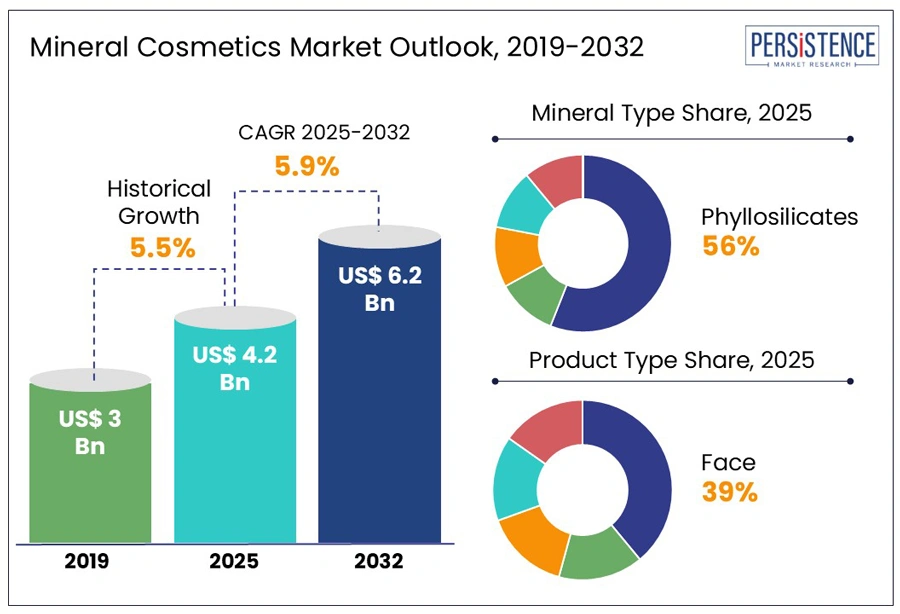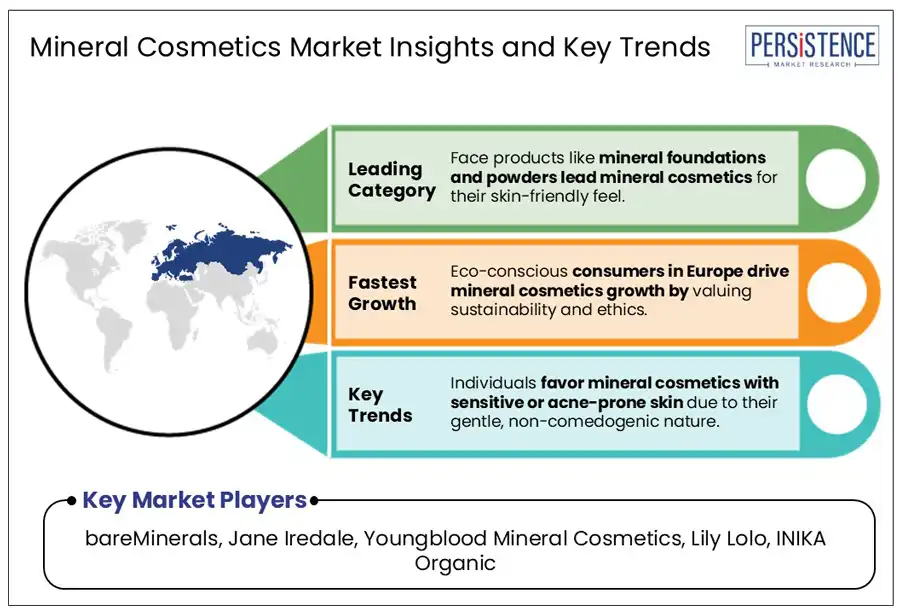ID: PMRREP35424| 190 Pages | 19 Jun 2025 | Format: PDF, Excel, PPT* | Consumer Goods

The global mineral cosmetics market size from US$ 4.2 Bn in 2025 to US$ 6.2 Bn by 2032. It is projected to grow at a CAGR of 5.9% from 2025 to 2032.
According to the Persistence Market Research report, the global mineral cosmetics market is driven by rising consumer demand for clean, skin-friendly beauty products. Mineral cosmetics are known for their non-toxic features and are suitable for sensitive skin. Moreover, the innovation in natural formulations and an increasing awareness of ingredient safety continue to shape market trends and preferences.

Key Industry Highlights:
|
Global Market Attribute |
Key Insights |
|
Mineral Cosmetics Market Size (2025E) |
US$ 4.2 Bn |
|
Market Value Forecast (2032F) |
US$ 6.2 Bn |
|
Projected Growth (CAGR 2025 to 2032) |
5.9% |
|
Historical Market Growth (CAGR 2019 to 2024) |
5.5% |
As awareness grows about the potential health risks associated with synthetic chemicals in conventional cosmetics, consumers are becoming more selective and conscious of product ingredients. Approximately 70% of consumers desire transparency regarding ingredient sourcing in their beauty products, reflecting a growing demand for clean-label cosmetics.
This shift has led to a growing demand for beauty products thfat are natural, safe, and sustainable. Mineral cosmetics, formulated with minimal and non-irritating ingredients such as zinc oxide, titanium dioxide, and iron oxides, have emerged as a preferred choice. Their free-from claims, excluding parabens, talc, synthetic dyes, and fragrances, make them especially suitable for sensitive skin types. Social media, influencer advocacy, and ingredient transparency are further fueling this transition, encouraging brands to innovate cleaner, mineral-based product lines.
Naturals launched Pearl, a new organic beauty brand featuring 18 products for skin and hair care. All products are 100% natural and chemical-free, catering to consumers seeking clean and sustainable beauty options.
While mineral cosmetics are widely praised for their gentle, non-toxic formulations and suitability for sensitive skin, they often struggle to match the vibrant pigmentation and staying power of conventional makeup products. This limitation is noticeable in categories such as eyeshadows, lipsticks, and eyeliners, where bold color and long-lasting wear are key expectations.
Consumers who enjoy experimenting with vivid makeup looks or who require products that withstand long hours, such as performers, professionals, or event attendees, may find mineral cosmetics less appealing. As a result, despite the growing demand for clean beauty, performance gaps continue to be a restraint on full market conversion.
Expanding product lines into mineral-based skincare hybrids offers significant growth potential by meeting consumer demand for multifunctional, time-saving beauty solutions. These hybrid products, such as mineral BB creams, tinted moisturizers with SPF, and serum-infused foundations, combine the cosmetic benefits of makeup with the nourishing properties of skincare.
BeautyStat introduced a mineral-based lip serum combining SPF 30 protection with vitamin C and peptides. This product aims to protect and brighten lips while maintaining a clean formulation free from synthetic additives.
Jones Road launched the "Just Enough" Tinted Moisturizer, offering hydrating coverage that merges skincare benefits with makeup. This product caters to consumers seeking a natural finish with added skin nourishment.
As consumers increasingly seek products that support skin health while enhancing appearance, brands that innovate in this space can gain a competitive edge. The natural, non-irritating ingredients found in mineral formulations further appeal to users with sensitive skin, making hybrid offerings especially attractive in the clean beauty segment. This trend fosters both product diversification and brand loyalty.
Phyllosilicates are the most dominant mineral category in the global mineral cosmetics market, widely valued for their natural origin, versatility, and skin-compatible properties. This group includes mica, talc, and kaolin, each serving essential functions across a range of cosmetic products.
Mica is used extensively for its shimmering, light-reflective qualities, making it a key ingredient in highlighters, eyeshadows, and luminous foundations, while also improving texture and blendability.
The dominance of phyllosilicates is reinforced by their ability to meet both performance and clean beauty standards, making them integral to modern, skin-friendly mineral cosmetic formulations.
Face products, especially mineral foundations and powders, continue to dominate demand within the global mineral cosmetics market due to their skin-friendly, breathable nature. These products are highly favored by consumers with sensitive or acne-prone skin, as they typically avoid harsh chemicals, preservatives, and synthetic dyes. The lightweight texture of mineral face makeup allows for a natural finish while enabling the skin to breathe, reducing the risk of pore clogging or irritation.
Many formulations offer added benefits such as SPF protection and anti-inflammatory ingredients, making them a go-to choice for daily wear. Their popularity supports sustained market growth and innovation.

Strong dermatological endorsement of non-comedogenic mineral makeup is playing a vital role in boosting consumer trust and accelerating product adoption. As skin health becomes a top priority, dermatologists frequently recommend mineral cosmetics for individuals with acne, rosacea, or sensitive skin due to their gentle, breathable formulations. Unlike traditional makeup, mineral products typically exclude pore-clogging ingredients, synthetic fragrances, and harsh preservatives, reducing the risk of irritation or breakouts. This clinical backing not only reassures cautious consumers but also encourages first-time buyers to switch to safer alternatives. The growing visibility of dermatologist-approved labels further legitimizes the segment and strengthens its market appeal.
In Europe, a growing population of eco-conscious consumers is significantly influencing the mineral cosmetics market by prioritizing sustainability and ethical sourcing. These buyers increasingly seek products that not only offer clean, skin-safe formulations but also align with their environmental and social values. As a result, mineral makeup brands are focusing on sustainably sourced ingredients, recyclable or biodegradable packaging, and cruelty-free, vegan-certified labels to meet this demand.
Certifications from organizations such as The Vegan Society or COSMOS Organic further validate these claims, attracting environmentally aware consumers. This trend is compelling brands to innovate responsibly, thereby reshaping product development and marketing strategies across the region.
Rising consumer awareness of natural and holistic beauty solutions is significantly driving the online sales of mineral cosmetics. With increasing concerns over skin health, pollution, and synthetic chemical exposure, consumers are turning to clean-label, mineral-based products that promise gentler, safer application. E-commerce platforms and beauty-focused online marketplaces are playing a crucial role by offering wider accessibility, product education, and ingredient transparency.
Influencers and dermatologists across the region are also promoting mineral makeup for its non-toxic and breathable qualities. This shift is encouraging both local and international brands to strengthen their digital presence and expand clean beauty lines.
The global mineral cosmetics market is characterized by intense competition, driven by rising demand for clean-label, skin-friendly beauty products. Market players focus heavily on product innovation, especially in multifunctional and hybrid formulations that combine makeup with skincare benefits. Brands are also investing in sustainable packaging, vegan certifications, and dermatologist endorsements to appeal to conscious consumers.
Online and omnichannel strategies are pivotal, with companies leveraging e-commerce, influencer marketing, and virtual try-on technologies to expand reach. The competitive landscape is further shaped by frequent new launches, R&D in natural ingredients, and regional customization to cater to diverse skin tones and preferences globally.
The global mineral cosmetics market is projected to value at 4.2 Bn in 2025.
The mineral cosmetics market is driven by rising consumer preference for clean-label beauty products.
The mineral cosmetics market is poised to witness a CAGR of 5.9% between 2025 and 2032.
Expanding product lines into mineral-based skincare hybrids are the key market opportunities.
Major players in the mineral cosmetics market include bareMinerals, Jane Iredale, Youngblood Mineral Cosmetics, Lily Lolo, INIKA Organic, and others.
|
Report Attribute |
Details |
|
Historical Data/Actuals |
2019 - 2024 |
|
Forecast Period |
2025 - 2032 |
|
Market Analysis Units |
Value: US$ Bn/Mn, Volume: As applicable |
|
Geographical Coverage |
|
|
Segmental Coverage |
|
|
Competitive Analysis |
|
|
Report Highlights |
|
|
Customization and Pricing |
Available upon request |
By Mineral Type
By Product Type
By Distribution Channel
By Region
Delivery Timelines
For more information on this report and its delivery timelines please get in touch with our sales team.
About Author